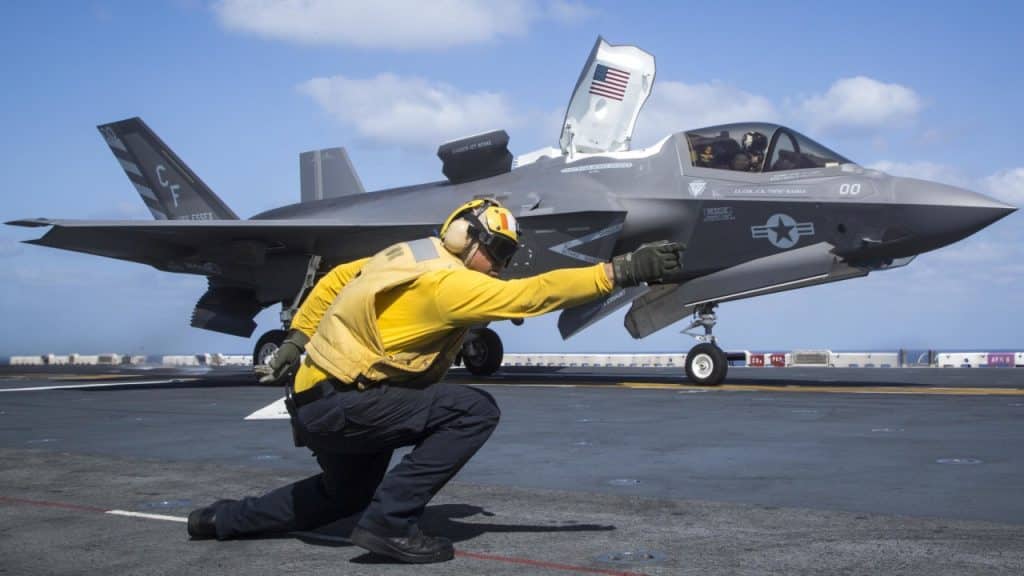After a break of more than a month and a half, the Pentagon resumed the collection of F-35 fighter jets from Lockheed Martin. Deliveries of new machines were suspended due to the decision of the Department of Defense on August 31, after the detection of elements made of materials from China in one of the parts supplied by Honeywell. The non-enforcement acceptance is provided for nine machines of the 13th production batch and 117 of the 14th batch.
Chinese cobalt and samarium alloys were used to produce the magnets found in the turbine lubrication pumps of the auxiliary power unit (used when the machine was stopped and the main Pratt & Whitney F135 engine started). The problem was discovered on August 19, but the decision to suspend the receipt of new fighters was made only two weeks later. The use of material from the Middle Kingdom – now the main geopolitical rival of the United States – violated DFARS (Supplement to the Federal Defense Procurement Law).
After the decision to suspend deliveries, the Department of Defense initiated an investigation to determine to what extent the use of the components violated the regulations and whether their use affects the safety of the machines in use. The inspection carried out by the Joint Program Office together with Lockheed did not reveal the risk of using fighters with Chinese magnets, and the components do not pose a risk of leakage of confidential information. The investigation also showed that the unfortunate elements are present in all delivered aircraft. We are talking about over 800 fighters.
F135 engine test.
(Rick Goodfriend)
In response to comments from the Pentagon, Honeywell changed its sub-supplier to a US-based company. The first F-35s with “legal” components are expected to roll off the production line in Batch 15 by the end of 2023. Lockheed Martin announced that, together with the American administration, it will audit procedures related to the supervision and control of supplies and suppliers. Despite the supply interruption, the company did not stop the production of new aircraft in order to achieve its goal of building 153 aircraft in 2022.
Failure to properly supervise the sourcing of components could be the result of serious availability issues with the F135 engines. Pratt & Whitney has been struggling for years with the unavailability of parts for servicing, as well as timely deliveries of complete drives. Things did not ease the shift to the F-35 program that followed Turkey kicked out of the supply chain and the COVID-19 pandemic.
Dutch F-35A in test at Edwards base in the United States.
(Ministerie van Defensie, CC BY-SA 4.0)
Sources of raw materials for suppliers working under US arms programs are a constant source of threats. During his speech at the Pentagon, Bill LaPlante, undersecretary of defense, pointed out that supply problems for the F-35 indicate a greater challenge, which is supply chain supervision. Since the end of the Cold War and allowing more extensive cooperation between civilian enterprises, the US raw material and component base began to shrink, which in turn led to an increase in dependence on supplies from East Asia.
The Joint Strike Fighter program has been plagued by problems with the presence of Chinese components since its inception. A similar incident happened in 2019, when Lockheed Martin bought circuit boards from a British company that was largely Chinese-owned. The fifth generation combat aircraft development and construction program is the largest defense program in the history of the United States. Currently, about 1,900 companies are involved in the production process of the F-35, including companies belonging to the Polish Armaments Group.
Pilot of the 355th US Air Force Squadron is preparing to take off in the F-35A.
(US Air Force / Airman 1st Class Elizabeth Schoubroek)
In addition to the immediate threat of Chinese industrial espionage or sabotage attempts, the communist state could indirectly paralyze the American arms industry by invading Taiwan. The Republic of China is a world leader in the production of semiconductors and integrated circuits.
TSMC is responsible for the production of approximately 92% of all ICs, including those used in the F-35 on-board computers. The scale of the use of Taiwanese parts by the US defense industry is unknown, but after the recent events in the Taiwan Strait, Washington increased pressure on TSMC to create an integrated circuit factory in the US for the military market.
Regardless, in August 2022, Joe Biden signed the CHIPS Act, which lays the groundwork for the development of domestic capabilities in the design and production of electronic components. The program is to make investments worth around $ 150 billion, of which about 30% will come from private companies. China is in a similar situation, which is also largely dependent on Taiwanese chips. Due to restrictions imposed by the Trump administration on Huawei, TSMC stopped selling integrated circuits, which threatened the production of phones capable of operating on the 5G network.
Not only integrated circuits cause a headache for logisticians planning production in American companies. Rare earth metals are also a problem. The resources, widely used in advanced electronics, are largely found in China. It is estimated that 417 kilograms of REE are needed to produce one F-35. Problems with proper securing of the supply chain and dependence on external producers also mean less expenditure on the development of native technologies, and consequently, it may result in the loss of technological advantage in the future.
See also: New Constant Phoenix finally flies
US Marine Corps / Cpl. Francisco J. Diaz Jr.

